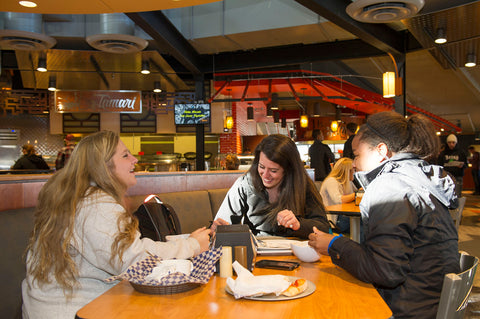Montana State University doubles down on local foods

Students at Montana State University
By Jodi Hausen
Those breakfast potatoes Montana State University students devour on campus, they’re made with potatoes from Whitehall and fried in safflower oil from Big Sandy.
Those fancy coffee drinks -- brewed with beans roasted in Whitefish. The dough for Miller Dining Hall’s hand-thrown pizzas (up to 600 in a day), is made from Montana-sourced wheat.
“And as you can imagine, that’s a lot of dough,” MSU Executive Chef Martin Lewis said.
Though he may not have realized it, Lewis was speaking both literally and figuratively.
MSU spent just over $1 million on Montana-produced food products last fiscal year. This year the locally sourced food budget promises to meet or exceed that level, having already exceeded $873,000.
On campus, food is served in three dining halls, 11 retail operations including concessions and at various events by the university’s catering service. In his role as dining hall chef and MSU’s interim Montana-made coordinator, Lewis knows intimately how much of the college’s food is produced within the state -- about one-fifth, in fact.
MSU has been buying some Montana-made products for years -- Wilcoxson’s ice cream and Montana Coffee Traders coffee, for example. But in 2006, the university food services launched an initiative to source as much locally produced food as possible.
“But when we started, it was really hard to source local food,” said Mike Kosevich, general manager of MSU’s dining halls.
For one, many vendors just couldn’t keep up with MSU’s quantity needs. Many small producers, who typically sold their products directly to customers at farmers’ markets or through community-supported agricultural co-ops, weren’t schooled in invoicing, food delivery practices and required licensing.
So MSU staff, including a Montana-made coordinator, began to work individually with vendors to help them jump those hurdles, said Todd Jutila, director of University Food Services. The coordinator helps vendors plan for the university’s needs, making recommendations on what and how much to plant, how many cattle to raise based on MSU’s projected demand and how to raise food for large-scale operations.
“They’ve been our North Star through the whole growth process,” said Garl Germann, owner of Montana Meat Company, “from four years ago when we first pitched selling grass-fed beef to MSU to now.”
But MSU’s orders quickly depleted the McAllister ranch’s beef. So Germann began contacting other area ranchers who used similar cattle-raising practices. After recruiting several, Germann founded Montana Meat Company – a co-op of ranchers who rely on Germann to process and sell their beef and other meats to a variety of venues from small restaurants and grocers to large-scale organizations like MSU.
MSU also helped arrange to have Germann’s ground beef transported to an existing vendor in Spokane on what would otherwise have been empty trucks. The vendor’s large-scale patty-making machine turned Germann’s beef into hamburger patties that met MSU’s specifications. Last semester, Montana Meat Company sold about 20,000 pounds of beef patties to MSU.
The result: Montana Meat Company grew at a rate that was “anything but normal,” Germann said. He went from being sole proprietor to having 10 employees, thanks, in part, to a recently awarded grant. But without MSU’s help, Montana Meat Company would not be making one-sixth of its revenue from university sales, Germann said.
As MSU’s first dining hall executive chef, Lewis is a driving force behind much of MSU’s drive to use locally sourced food.
The offerings of fresh, locally grown fruits and vegetables on campus has increased due to the creation of Root Cellar Foods, a Belgrade-based produce distributor that works with several local growers. Before Root Cellar Foods was established, Lewis could choose to buy fresh produce shipped from California or locally grown produce that was frozen or unprocessed. Now he gets the best of both worlds. MSU will likely purchase 20 times more produce from local growers this year than it did last, he added.
Lewis says knowing his vendors personally enables him to develop specific products to fit his recipes, allowing him to be more creative.
“I go out and source products and have relationships with the producers,” he said. “I can’t have a relationship with a large, national vendor and say, ‘I like your chicken breast, but can you customize it to fit my needs?’ It fits the goal of creating better quality food for the customers and it’s a process where everyone wins. The product is better in the end.”
Kristin Blackler, director of the MSU Office of Sustainability, said it makes sense for the university to support local producers, particularly because MSU is home to the College of Agriculture, MSU Extension, the sustainable food and bioenergy systems program and a host of entrepreneurship programs.
“I am proud of the commitment MSU has made to offer more local food in our dining halls,” she said. “It’s exciting to watch the program grow and improve each year.”
Blackler is coordinating MSU’s efforts for the Governor’s Food and Agriculture Summit, set for Friday, Oct. 28, and Saturday, Oct. 29, in MSU’s SUB Ballrooms. The summit will explore the complexity of Montana’s agricultural and food system and develop a roadmap for growing that sector’s economy by creating statewide platforms for networking and mentoring, among other things. For more information, contact Blackler at Kristin.blackler@montana.edu or at 994-6825.




